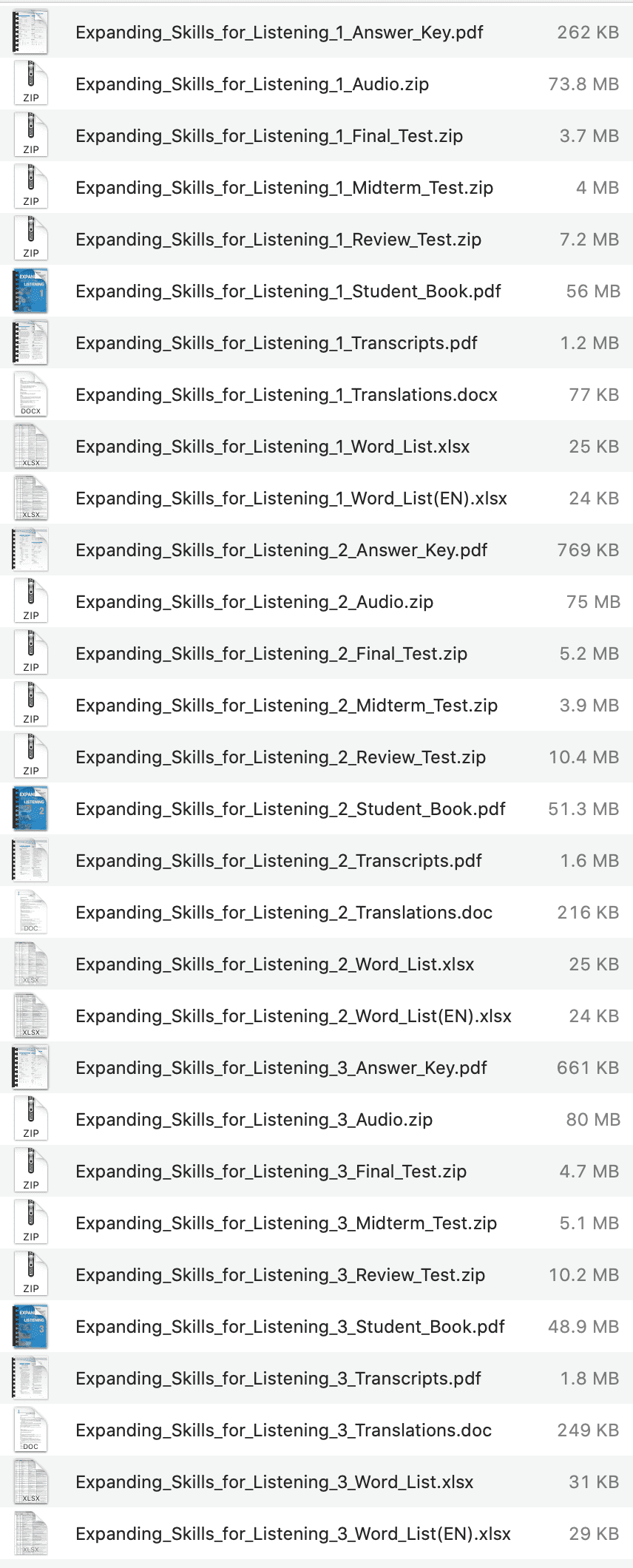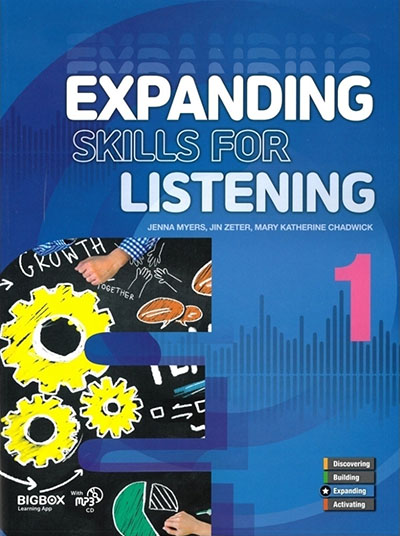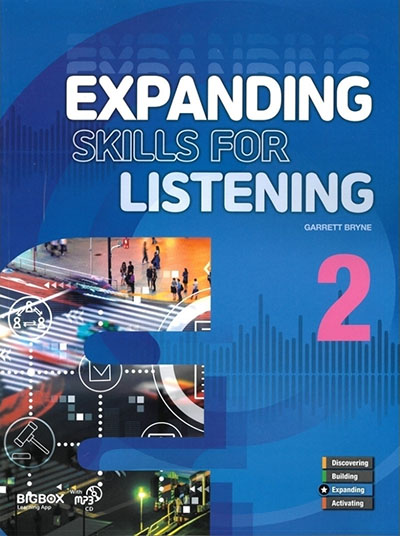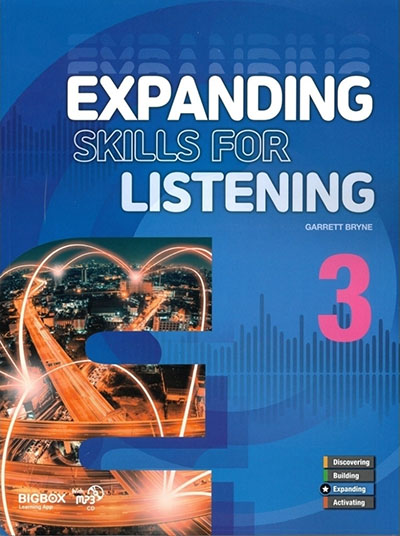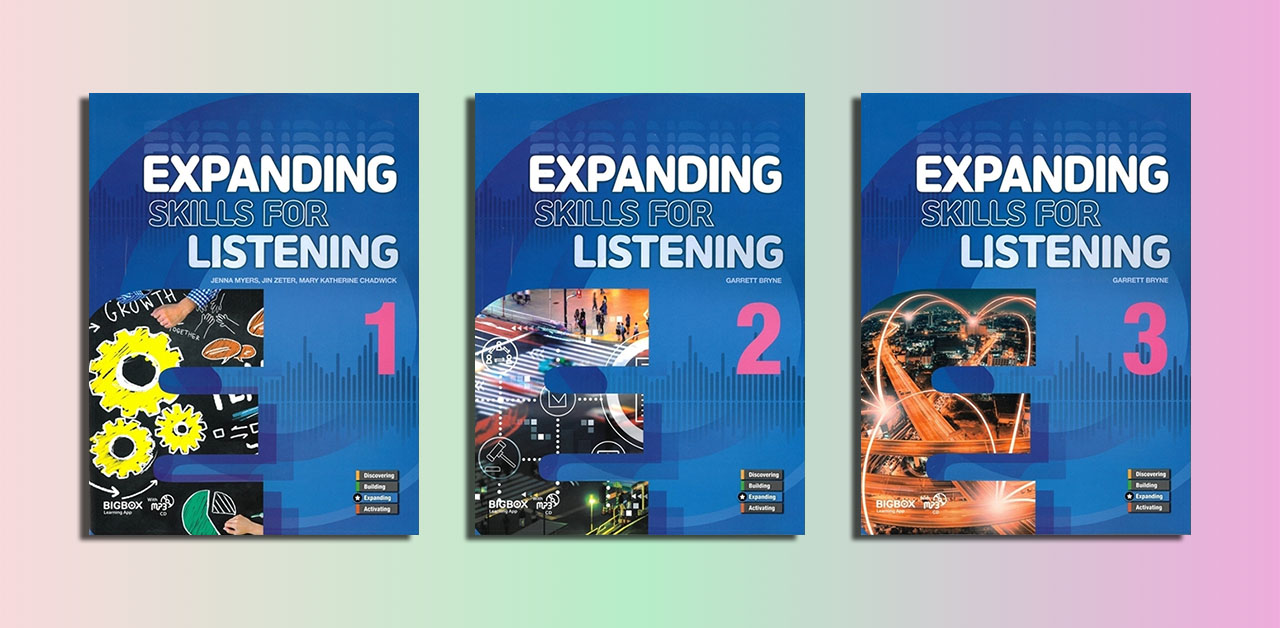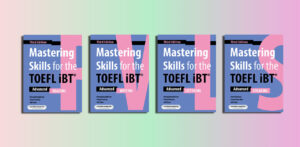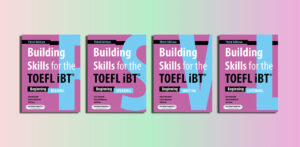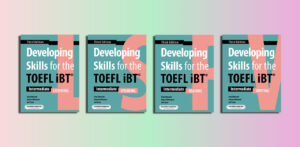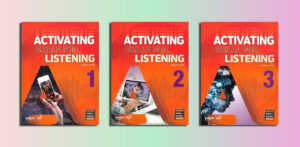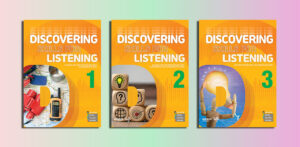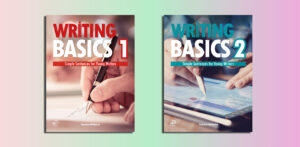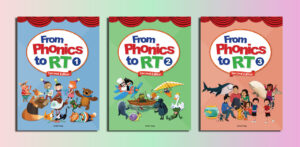Compass, Download, Online iTools
Download Expanding Skills for Listening Pdf Resources (A1 / A2)
Expanding Skills for Listening (PDFs, Resources)
Level 1 (A1 – A1+)
Expanding Skills for Listening 1 Student’s Book.pdf – Sample: Click
Answer Key – Audio – Final Test – Midterm Test – Review Test – Student Book – Transcripts – Word List
Level 2 (A1+ – A2)
Expanding Skills for Listening 2 Student’s Book.pdf – Sample: Click
Answer Key – Audio – Final Test – Midterm Test – Review Test – Student Book – Transcripts – Word List
Level 3 (A2)
Expanding Skills for Listening 3 Student’s Book.pdf – Sample: Click
Answer Key – Audio – Final Test – Midterm Test – Review Test – Student Book – Transcripts – Word List
Discovering Skills for Listening (Pre A1 / A1): Click here
Building Skills for Listening (Pre A1 / A1): Click here
Expanding Skills for Listening (A1 / A2): Click here
Activating Skills for Listening (A2 / B1): Click here
Overview of the “Expanding Skills for Listening” by Compass Publishing
Contents
- 1 Overview of the “Expanding Skills for Listening” by Compass Publishing
- 2 Who is suitable for “Expanding Skills for Listening”?
- 3 The benefits of “Expanding Skills for Listening”
- 4 Effective learning strategies for “Expanding Skills for Listening”
- 5 Effective teaching strategies for “Expanding Skills for Listening”
| ✅ Coursebook: | Expanding Skills for Listening |
| ✅ Publisher: | Compass Publishing |
| ✅ Authors: | Jenna Myers, Jin Zeter, Mary Katherine Chadwick, Garrett Bryne |
| ✅ 7 Levels: | A1, A1+, A2 |
| ✅ Skills: | Listening |
| ✅ For: | Primary School |
| ✅ Publication year: | 2020 |
General Description:
- Purpose: Part of a four-part series aimed at building, strengthening, and expanding English listening skills for young learners, focusing on practical, everyday communication.
- Target Audience: Covers CEFR levels A1 to A2+, designed for beginner to low-intermediate learners, with each level progressively advancing proficiency.
- Components: Includes a student book (152 pages, 210×278 mm), audio tracks (available via SoundCloud), a teacher’s guide with answer keys and tips, and online resources (e.g., PDFs, flashcards, quizzes) accessible via Compass Publishing’s website or eltebook.com.
Level Breakdown:
Level 1 (A1 – A1+):
- Writer: Jenna Myers, Jin Zeter, Mary Katherine Chadwick
- ISBN: 978-1-64015-383-7
- Focus: Introduces basic listening with natural dialogues for beginners, focusing on simple phrases and everyday scenarios.
Level 2 (A1+ – A2):
- Writer: Garrett Byrne
- ISBN: 978-1-64015-384-4
- Focus: Builds on foundational skills with varied dialogues in everyday settings, suitable for low-intermediate learners.
Level 3 (A2):
- Writer: Garrett Byrne
- ISBN: 978-1-64015-385-1
- Focus: Strengthens A2 listening skills, preparing learners for more complex interactions and progression toward A2+ or B1.
Key Features:
- Natural Dialogues: Realistic conversations in everyday contexts to enhance practical listening.
- Exercises and Passages: Multiple exercises per unit for varied exposure and comprehension practice.
- Standardized Testing: Unit tests styled like standardized exams to prepare for formal assessments.
- Dictation Booklet: Provides additional listening practice and reinforces learned phrases.
Pedagogical Approach:
- Uses engaging, context-rich content with illustrations to reduce anxiety and focus on main ideas. Integrates listening with vocabulary and speaking, supported by audio and workbook activities tailored to each level.
Expanding Skills for Listening 1
Who is suitable for “Expanding Skills for Listening”?
Suitable Learners:
Young Learners:
- Primarily aimed at children or teenagers learning English as a second or foreign language.
- The engaging, context-rich content with vivid illustrations appeals to younger audiences, making it ideal for classroom or self-study settings.
CEFR Levels A1 to A2+:
- Level 1 (A1 – A1+): True beginners who can understand and use basic phrases (e.g., greetings, daily routines). Suitable for learners just starting their English journey.
- Level 2 (A1+ – A2): Low-intermediate learners who can handle familiar topics and simple dialogues (e.g., shopping, travel). Ideal for those building on foundational skills.
- Level 3 (A2): Learners who can understand everyday scenarios and are ready to progress toward A2+ or B1, focusing on slightly more complex interactions.
Learners Needing Practical Listening Skills:
- Best for students aiming to improve listening in real-life contexts. The series features natural dialogues in everyday settings (e.g., school, home, public places), helping learners understand practical language use.
Students Preparing for Standardized Tests:
- The inclusion of standardized testing-style unit tests makes it suitable for learners preparing for language proficiency exams at beginner to low-intermediate levels.
Classroom or Self-Study Learners:
- Supported by a teacher’s guide, audio tracks (via SoundCloud), and online resources (e.g., PDFs, flashcards, quizzes on Compass Publishing’s site or eltebook.com), it’s adaptable for both guided classroom instruction and independent study.
Additional Considerations:
- Support Needs: A1 learners may require teacher scaffolding (e.g., slower audio, pre-taught vocabulary), while A2 learners can engage more independently.
- Not Suitable For: Advanced learners (B1 and above) or adults seeking specialized listening skills (e.g., business English), as the content is tailored for younger, beginner to low-intermediate students.
Summary:
“Expanding Skills for Listening” is ideal for young learners at CEFR A1 to A2+, particularly those needing practical listening practice in everyday contexts, whether in a classroom or self-study environment.
Expanding Skills for Listening 2
The benefits of “Expanding Skills for Listening”
Benefits:
Improves Practical Listening Skills:
- Features natural dialogues in everyday settings (e.g., school, home, travel), helping learners understand real-life conversations and build confidence in listening to spoken English.
Progressive Skill Development:
- Spans Levels 1 (A1-A1+), 2 (A1+-A2), and 3 (A2), providing a structured progression that builds foundational listening skills and prepares learners for higher proficiency (A2+ to B1).
Engaging and Age-Appropriate Content:
- Designed for young learners, the series uses vivid illustrations and relatable topics to maintain engagement, reducing listening anxiety and making learning enjoyable.
Varied Exposure Through Exercises:
- Multiple exercises and passages per unit offer diverse listening practice, ensuring learners encounter different contexts, accents, and speaking styles, which enhances comprehension.
Supports Test Preparation:
- Includes standardized testing-style unit tests, helping learners familiarize themselves with exam formats and improve their performance in language proficiency assessments.
Reinforces Learning with Supplementary Materials:
- Comes with a dictation booklet for extra listening practice, reinforcing learned phrases. Audio tracks (via SoundCloud) and online resources (e.g., flashcards, quizzes on Compass Publishing’s site or eltebook.com) provide additional support.
Integrates Multiple Skills:
- Combines listening with vocabulary building and speaking practice, fostering a well-rounded language foundation. Workbook activities and teacher’s guide (with answer keys and tips) further consolidate learning.
Flexible for Different Learning Environments:
- Suitable for both classroom and self-study, with resources adaptable to guided instruction or independent practice, catering to diverse learner needs.
Summary:
“Expanding Skills for Listening” enhances practical listening skills, supports progressive learning, and prepares young A1 to A2+ learners for real-world communication and exams through engaging, structured content and supplementary materials.
Expanding Skills for Listening 3
Effective learning strategies for “Expanding Skills for Listening”
Effective Learning Strategies:
Pre-Listening Preparation:
- Vocabulary Preview: Before each unit, review key vocabulary and phrases using the workbook or online flashcards (available via Compass Publishing’s site or eltebook.com). For A1 learners, focus on high-frequency words; for A2, include simple expressions.
- Set Context: Discuss the unit’s topic (e.g., shopping, daily routines) using the book’s illustrations to activate prior knowledge and prepare learners for the listening content.
Active Listening Techniques:
- Listen for Gist First: Encourage learners to focus on the main idea of dialogues rather than every word. For example, in Level 1, ask, “What are they talking about?” (e.g., greeting, family).
- Multiple Listens: Play audio tracks (accessible via SoundCloud) 2-3 times: first for general understanding, then for specific details (e.g., answering true/false questions), and finally to confirm answers.
- Slow Playback for Beginners: For A1 learners, slow down audio playback to help them process spoken English. Gradually increase speed as they progress to A2.
Engage with Exercises Actively:
- Varied Practice: Use the multiple exercises per unit (e.g., gap-fills, matching) to reinforce comprehension. For Level 2 and 3 learners, encourage predicting answers before listening to build anticipation skills.
- Dictation Practice: Use the accompanying dictation booklet to write down short phrases or sentences, improving listening accuracy and spelling. For A2 learners, focus on full sentences; for A1, stick to key words.
Post-Listening Reinforcement:
- Summarize and Discuss: After listening, have learners summarize the dialogue in simple sentences or discuss it with peers (e.g., “What did they buy?”). This integrates speaking practice, especially for Level 3 learners.
- Repeat and Shadow: Replay audio and have learners repeat or shadow (mimic) the speaker to improve pronunciation and intonation, particularly helpful for A1+ to A2 learners.
Leverage Supplementary Materials:
- Online Resources: Use downloadable quizzes and flashcards from Compass Publishing’s site or eltebook.com for extra practice. For example, A1 learners can match pictures to words, while A2 learners can complete comprehension quizzes.
- Teacher’s Guide: Educators can use the guide’s tips and extra activities (e.g., role-plays) to extend learning. For self-learners, review answer keys to self-assess progress.
Regular Testing and Reflection:
- Unit Tests: Use the standardized testing-style unit tests to gauge progress and familiarize learners with exam formats. For A2 learners, review incorrect answers to identify weak areas.
- Track Improvement: Encourage learners to note how many questions they answer correctly over time, building confidence as they move from Level 1 to 3.
Create a Routine:
- Daily Listening: Dedicate 10-15 minutes daily to listening practice, especially for self-learners. For example, at 2:21 PM +07 on a Thursday like today, May 22, 2025, a learner could complete one unit’s audio exercises.
- Mix Levels Gradually: As learners improve (e.g., from A1+ to A2), introduce Level 2 or 3 units to challenge them while revisiting Level 1 for reinforcement.
Summary:
Effective strategies for “Expanding Skills for Listening” include pre-listening preparation, active listening with multiple plays, engaging with exercises, reinforcing through discussion and dictation, leveraging online resources, regular testing, and maintaining a consistent routine. These approaches cater to A1 to A2+ learners, ensuring progressive improvement in listening skills.
Effective teaching strategies for “Expanding Skills for Listening”
Effective Teaching Strategies:
Scaffold Learning for Different Levels:
- Level 1 (A1-A1+): Pre-teach basic vocabulary using flashcards (available on Compass Publishing’s site or eltebook.com) and simplify instructions. Use gestures or visuals from the book to support understanding.
- Level 2 (A1+-A2): Introduce slightly more complex phrases and encourage prediction (e.g., “What will they talk about next?”) before listening.
- Level 3 (A2): Focus on listening for specific details and encourage summarizing dialogues to prepare for A2+ progression.
Create an Interactive Listening Environment:
- Warm-Up Activities: Start with a 5-minute warm-up related to the unit’s topic (e.g., for a shopping unit, ask, “What do you buy at a store?”). Use the book’s illustrations to engage students.
- Group Listening: Play audio tracks (via SoundCloud) and have students work in pairs to answer questions, fostering collaboration. For example, one student listens for the main idea, the other for details.
Differentiate Audio Exposure:
- Multiple Plays with Purpose: Play each dialogue 2-3 times: first for gist, then for specific answers (e.g., true/false), and finally to check responses. For A1 learners, slow down playback; for A2, maintain natural speed.
- Pause and Discuss: Pause audio at key points to ask questions (e.g., “What did she say about her family?”), ensuring comprehension, especially for Level 1 students.
Incorporate Varied Activities:
- Dictation Practice: Use the dictation booklet to have students write down phrases, reinforcing listening and spelling. For A1, focus on single words; for A2, use short sentences.
- Role-Plays: After listening, use the teacher’s guide suggestions to create role-plays based on dialogues (e.g., a shopping scenario), integrating speaking skills, especially for Level 3 students.
- Unit Tests: Use the standardized testing-style tests to assess progress and familiarize students with exam formats, adjusting difficulty based on level.
Encourage Active Participation:
- Questioning Techniques: Ask open-ended questions post-listening (e.g., “Why did he say that?” for Level 3) to promote critical thinking. For Level 1, use yes/no questions.
- Peer Feedback: Have students share answers in small groups, encouraging peer correction and discussion to build confidence.
Monitor and Reflect:
- Track Progress: Use a simple checklist to monitor each student’s improvement across units, noting areas like vocabulary recognition or detail comprehension.
- Provide Feedback: After exercises, give specific feedback (e.g., “You identified the main idea well, but let’s work on hearing numbers better”), tailoring it to each level’s needs.
Summary:
Effective teaching strategies for “Expanding Skills for Listening” include scaffolding for different levels, creating an interactive environment, differentiating audio exposure, using varied activities, leveraging resources, encouraging participation, and monitoring progress.

